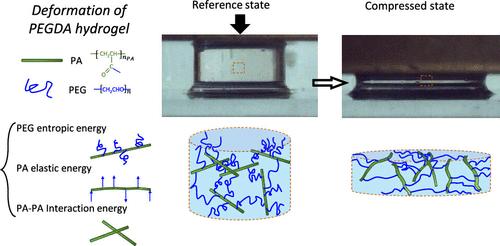了解聚乙二醇二丙烯酸酯 (PEGDA) 水凝胶网络的反应:基于统计力学的框架
IF 5.1
1区 化学
Q1 POLYMER SCIENCE
引用次数: 0
摘要
聚(乙二醇)二丙烯酸酯(PEGDA)水凝胶具有生物相容性和大变形能力等许多有前途的特性,是广泛应用的理想候选材料。有趣的是,PEGDA 的聚合会产生一种与 "经典 "聚合物凝胶根本不同的网络微结构。具体来说,PEGDA 水凝胶由 PEG 链组成,这些 PEG 链由作为交联剂的多功能密集接枝棒状聚丙烯酸酯 (PA) 相互连接。在这项工作中,我们推导出了一个微结构模型,该模型捕捉到了 PEGDA 水凝胶发生变形的基本特征:(1) PEG 链的熵弹性,(2) PA 杆的变形,以及 (3) PA-PA 的相互作用。推导出了能量密度函数的表达式以及与这三种贡献相关的应力。该模型展示了加载过程中网络的微观结构演变,并揭示了关键微观量的作用。为了验证该模型,我们制作并压缩了 PEGDA 水凝胶盘。对于各种 PEGDA 成分,该模型与我们的实验结果非常吻合。有趣的是,我们发现具有短 PEG 链和长 PA 棒的 PEGDA 水凝胶的反应受 PA-PA 相互作用的支配,而具有较长 PEG 链的网络则受熵的支配。为了便于设计,我们利用该模型研究了关键微观结构量(如 PEG 和 PA 链的长度)对宏观特性和响应的影响。这项工作的发现为高效设计具有可调特性和行为的 PEGDA 水凝胶铺平了道路,这将有助于优化它们在各种应用中的性能。本文章由计算机程序翻译,如有差异,请以英文原文为准。

Understanding the Response of Poly(ethylene glycol) diacrylate (PEGDA) Hydrogel Networks: A Statistical Mechanics-Based Framework
Thanks to many promising properties, including biocompatibility and the ability to experience large deformations, poly(ethylene glycol) diacrylate (PEGDA) hydrogels are excellent candidate materials for a wide range of applications. Interestingly, the polymerization of PEGDA leads to a network microstructure that is fundamentally different from that of the “classic” polymeric gels. Specifically, PEGDA hydrogels comprise PEG chains that are interconnected by multifunctional densely grafted rod-like polyacrylates (PAs), which serve as cross-linkers. In this work, we derive a microstructurally motivated model that captures the essential features which enable deformation in PEGDA hydrogels: (1) entropic elasticity of PEG chains, (2) deformation of PA rods, and (3) PA–PA interactions. Expressions for the energy-density functions and the stress associated with each of the three contributions are derived. The model demonstrates the microstructural evolution of the network during loading and reveals the role of key microscopic quantities. To validate the model, we fabricate and compress PEGDA hydrogel discs. The model is in excellent agreement with our experimental findings for a broad range of PEGDA compositions. Interestingly, we show that the response of PEGDA hydrogels with short PEG chains and long PA rods is governed by PA–PA interactions, whereas networks with longer PEG chains are dominated by entropy. To enable design, we employ the model to investigate the influence of key microstructural quantities, such as the length of the PEG and the PA chains, on the macroscopic properties and response. The findings from this work pave the way to the efficient design of PEGDA hydrogels with tunable properties and behaviors, which will enable the optimization of their performance in various applications.
求助全文
通过发布文献求助,成功后即可免费获取论文全文。
去求助
来源期刊

Macromolecules
工程技术-高分子科学
CiteScore
9.30
自引率
16.40%
发文量
942
审稿时长
2 months
期刊介绍:
Macromolecules publishes original, fundamental, and impactful research on all aspects of polymer science. Topics of interest include synthesis (e.g., controlled polymerizations, polymerization catalysis, post polymerization modification, new monomer structures and polymer architectures, and polymerization mechanisms/kinetics analysis); phase behavior, thermodynamics, dynamic, and ordering/disordering phenomena (e.g., self-assembly, gelation, crystallization, solution/melt/solid-state characteristics); structure and properties (e.g., mechanical and rheological properties, surface/interfacial characteristics, electronic and transport properties); new state of the art characterization (e.g., spectroscopy, scattering, microscopy, rheology), simulation (e.g., Monte Carlo, molecular dynamics, multi-scale/coarse-grained modeling), and theoretical methods. Renewable/sustainable polymers, polymer networks, responsive polymers, electro-, magneto- and opto-active macromolecules, inorganic polymers, charge-transporting polymers (ion-containing, semiconducting, and conducting), nanostructured polymers, and polymer composites are also of interest. Typical papers published in Macromolecules showcase important and innovative concepts, experimental methods/observations, and theoretical/computational approaches that demonstrate a fundamental advance in the understanding of polymers.
 求助内容:
求助内容: 应助结果提醒方式:
应助结果提醒方式:


